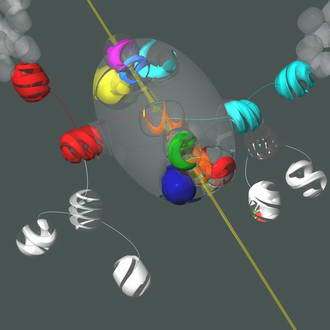Subatomic particles: An art form

Quarks, photons, gluons—physicists understand their characteristics, but didn't know what they may look like. That is until Jan-Henrik Andersen translated the physical properties of subatomic particles to images on paper and canvas.
Image: Top/Muon event from the Fermilab Tevatron © U-M Professor Jan-Henrick Andersen, School of Art & Design
Andersen, an assistant professor in the University of Michigan's School of Art & Design, is exhibiting "Sized Matter-Perception of the Extreme Unseen" through August at the Fermi National Accelerator Laboratory in Batavia, Ill.
The exhibition is a display of 25 large-scale vibrantly colored computer-generated images inked on canvas and paper, as well as sculpture, that give visual qualities to subatomic particles. Andersen has bridged the optically impossible task of visually observing these particles by translating their properties and classification, known as the Standard Model of Subatomic Physics, into a coherent visual language. Here, the properties of velocity, color, mass and spin are represented as visual elements.
"No one has ever seen, nor will anyone ever see anything as small or fast as a quark or a neutrino," Andersen said. "One could argue that they could look like anything, if they have looks at all."
Andersen worked with U-M physicists Gordon Kane and David Gerdes to blend art and science.
"We worked together for many months, somehow overcoming our different ways of understanding and describing the world," Kane said. "We succeeded in generating a set of images that are both meaningful and beautiful. Andersen generated the images while the rest of us helped keep them focused and scientifically valid."
Gerdes provided Andersen with examples of real particle interactions from the Collider Detector Facility (CDF) experiment at Fermilab where he does his research.
"I discussed with him what the event represents," Gerdes said. "One of these is the top quark production event that is featured in the exhibit. It is very exciting to see these events turned into art. "
According to Bryan Rogers, dean of U-M's School of Art & Design, Andersen's work "indisputably reveals the emerging new connections between art and science, between visual image and mathematical construct. It joins the two almost-lost cultural friends at their edges and opens the door for more artists and scientists to explore together."
"While science proposes and explains our world with measurable means, visual art and design offers an intellectual and emotional appreciation of that which cannot be explained by any other means, measurable or not," Andersen said.
Not satisfied with simply translating the physical properties of particles into images, Andersen became enthralled with translating the images and their curvilinear geometries and properties into functional objects.
"The visual logic of the geometries seen in the images was extended into real space where I experimented with the consequences of adding two more dimensions—human scale and function," Andersen said. "The goal was to generate a broader sensory response than provided through vision alone, to search for more physical ways to communicate visual language broadening the cognitive approach."
To accomplish this feat, Andersen constructed chairs as well as a little boat. These projects allowed him to balance the body, paralleling the equilibrium found in particle parity, thereby increasing the awareness of the limitations of our initial perceptions.
"The freedom from the constraints of scientific conventions may broaden our comprehension of our world," Andersen said. "And I have taken great pleasure in freely bridging science with design—hopefully for the enrichment of each as they are linked by a common beauty."
Source: University of Michigan















